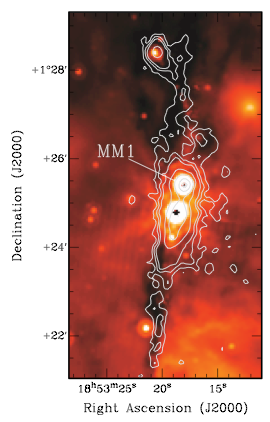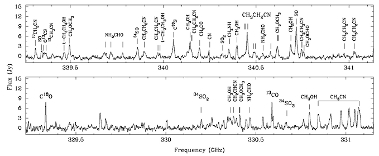|
What initial conditions form massive stars?
Massive stars are not found in all star forming regions. Herbig (1962) pointed out that the Orion region contains stars of all masses while the Taurus star-forming region contains stars no larger than 2 M⊙. The specific initial conditions in the interstellar medium (ISM) that lead to massive stars are still not understood. Why do some molecular clouds form massive stars while others do not? What are the physical properties that distinguish them?
The precursors to massive-star forming regions are thought to be the class of clouds known as infrared dark clouds (IRDCs). These giant clouds are the size of typical massive-star forming clouds but are dark in the infrared, implying that they have no significant sources of heat. Thus, these clouds have not yet produced massive stars but are thought to represent the state of clouds just prior to the formation of massive stars. Observers have used the high angular resolution of the SMA to determine the internal structure of the IRDCs (Rathborne et al. 2008; Fallscheer et al. 2009). Dust continuum observations find that the IRDCs contain dense (n > 105 cm-3) dust cores with cold temperatures (~10 K) and sizes (< 0.1 pc) right for likely sites of future massive stars. At these conditions, the cores far exceed the Jeans criteria suggesting that they were created by turbulent rather than thermal fragmentation. Spectral line observations find further evidence for the early stages of star formation in these cores such as coherent rotational motions (implying spin-up of the molecular gas during contraction) and broad spectral lines (indicating rapid inward and outward flows).
Several SMA observations seek to understand the evolutionary progression of the dense cores toward the formation of a massive protostar by comparing observations of cores at a sequence of evolutionary states (Beuther et al. 2009; Zhang et al. 2009). Molecular cores in later evolutionary stages are found to have higher gas temperatures, broader spectral line widths, and spectral lines from many more distinct molecular species, indicating the development of a characteristic hot core chemistry as a growing massive protostar heats its surroundings.
 |

Click here for larger view |
| Figure 1: (Left) Spitzer 24 mm image of the IRDC G034.43+00.24 with contours of 1.2mm continuum. (Above) SMA spectrum showing molecular lines in the hot core (Rathborne et al. 2008). |
» Next Page: Why do Massive Stars form only in massive clusters?
« Previous Page
SMA Research
| 


